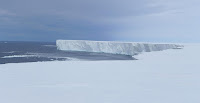Scientists have found that a portion of the Ross Ice Shelf in Antarctica, the world’s largest ice shelf and an important contributor to future global sea level rise, is melting 10 times faster than the rest of the shelf, according to a new study published in the journal Nature Geoscience.
The melting, the scientists say, is being driven by warm, ice-free ocean surface waters heated by the sun. As E&E News reports, while the process sounds simple, it is one that hasn’t been well-documented or studied until now. Most research has focused instead on the influence of deep-sea currents on Antarctic melting, rather than surface water.
The newly identified rapidly melting zone is at the front of the Ross Ice Shelf, where it juts out into a naturally ice-free part of the Southern Ocean, formed as the result of polar wind patterns. The area is a critical part of the shelf that helps to stabilize the flow of ice behind it. If the Ross Ice Shelf collapses, it could raise global sea levels by an estimated 16 feet.
The researchers warn their findings point to what could be another major source of Antarctic melting in the coming decades, both on the Ross Ice Shelf and elsewhere on the continent.
Read more at Warm Surface Water Temperatures Are Driving Melting on the World’s Largest Ice Shelf

No comments:
Post a Comment